AS Level Physics 9702
8. Superposition
Written by: Pranav I
Formatted by: Adhulan Rajkamal
Index
8.1 Superposition and interference of waves
- Principle of superposition: When two or more waves meet at a point, the resultant displacement at that point is equal to the sum of the displacement of the individual waves at that point
- Interference effects can be observed with all types of waves
Constructive and destructive interference
- The overlapping of two waves of the same frequency may produce an interference pattern
- Inphase incoming waves interfere constructively
- Antiphase incoming waves interfere destructively
- Path difference: The difference between the distances travelled by two waves to reach a point
- Whole number of wavelengths (nλ) → inphase + constructive interference
- Odd number of half-wavelengths (nλ + 0.5λ) → antiphase + destructive interference
- Note: Given that they are inphase in their initial points
- Fringes: The maxima and minima disturbances produced due to interference
- Interference pattern: The collection of fringes produced by the superposition of overlapping waves
Producing an interference pattern with sound waves
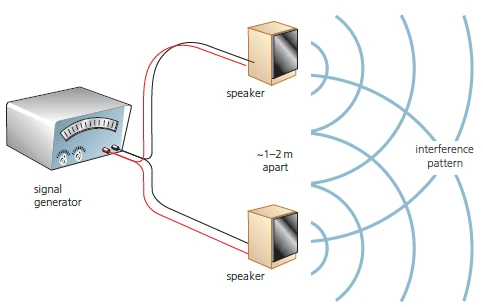
- Two loudspeakers connected to the same signal generator to produce waves of the same frequency
- Should be done in an open area, on a windless day
- The positions of fringes can be detected using a microphone and CRO
Producing an interference pattern with light waves
- Two separate light sources, even of the same frequency, produce incoherent waves
- Light is emitted as a series of pulses, and there is an abrupt change in phase between each pulse
- Coherent waves: Waves with a constant phase difference
- Note: same amplitudes are not necessary for observable interference patterns; they just enhance contrast
Young’s double-slit experiment
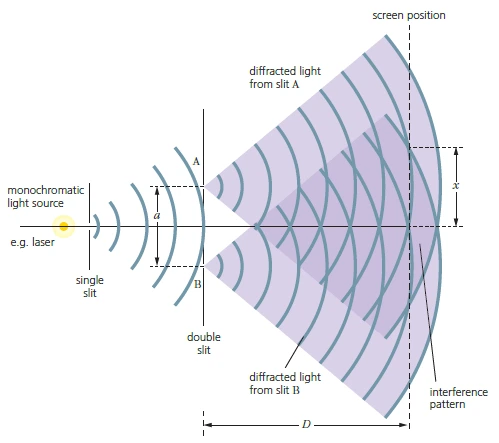
- Light waves from slits A and B are coherent since they originate from the same primary source.
- Fringe width, x: distance between successive bright or dark fringes
$$ x = \frac{\lambda D}{a} $$
- D → distance from the double slit to the screen
- a → distance between the centers of the slits
- D has to be large (1-2 m) and a has to be small (1-2 mm) since light has very small wavelengths.
Double-slit interference with microwaves
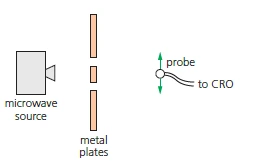
- Microwave source emits microwaves of a single frequency
- Metal plates produce a double-slit arrangement
- Constructive and destructive interference are detected by a microwave probe connected to a CRO
- Can be moved parallel to the metal plates to measure fringe width
The conditions for interference fringes to be observed
- Coherent sources have to be used → constant phase difference
- If transverse, unpolarized or polarized in the same plane
White light fringes
- White light is used in Young’s double-slit experiment
- Different wavelengths produce their own fringe pattern
- Centre of the pattern → white maxima with black fringes on both sides
- A pattern of white fringes with colored edges is formed by maxima and minima of different colors overlapping
8.2 Superposition and stationary waves
- Stationary wave: the result of the overlapping and hence interference of two waves of equal frequency and amplitude, travelling along the same line with the same speed but in opposite directions
Stationary waves on strings
- Node: a point of zero amplitude
- Antinode: a point of maximum amplitude

Fundamental node or first harmonic
- Wavelength of the fundamental node is \( 2L \).
- Therefore, \( f_1 = \frac{c}{2L} \) (where \( c \) is the speed of the progressive waves that interfered to produce the stationary wave).
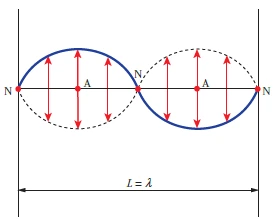
First overtone or second harmonic
- Wavelength \( \lambda = L \).
- \( f_2 = \frac{2c}{2L} = \frac{c}{L} \).

Second overtone or third harmonic
- Wavelength \( \lambda = \frac{2L}{3} \).
- \( f_3 = \frac{3c}{2L} \).
🔥 \( f_n = \frac{n c}{2L} \)
This is the general expression for the frequency \( f_n \) of the \( n \)th mode (the \( n \)th harmonic, or the \( (n-1) \)th overtone).
Differences between progressive and stationary waves
| All points have the same amplitude | Amplitude varies with position along the string: it is zero at a node and maximum at an antinode |
| The wavelength is the distance between adjacent points having the same phase (crest to crest or trough to trough) | The wavelength is twice the distance between adjacent nodes or antinodes |
| The waveform (crests and troughs) moves with the velocity of the wave | The nodes and antinodes do not move along the string |
| There is energy translation in the direction of movement of the waveform | There is no translational movement of energy, but energy is associated with the wave |
| Phase varies continuously along the wave → All neighbouring points are out of phase with each other | Between adjacent nodes, all points vibrate in phase; the particles between two adjacent nodes are 180° out of phase |
| There are no specific frequency constraints → the wave can have any frequency | Only certain resonant frequencies are possible, depending on the length of the string and the speed of the wave |
Explaining the formation of stationary waves
- Two waves of the same kind travelling in opposite directions overlap
- Waves have same frequency/wavelength and speed
- They form stationary waves
Stationary waves in air

- A fine, dry powder is sprinkled evenly along the tube
- While in resonant frequencies:
- The powders settles into heaps at nodes (no disturbance)
- The powder is dispersed in antinodes
- In a closed pipe, the closed end has a node and the open end has an antinode
- The antinode is slightly outside the open end → the distance is the end-correction
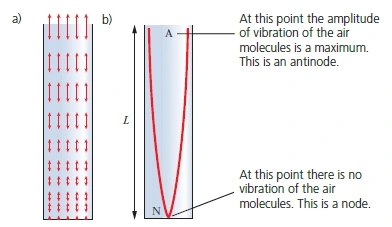
Fundamental mode of vibration of air in a closed pipe
- Sound waves are longitudinal, so air particles vibrate as shown in the figure
- Wavelength \( \lambda = 4L \)
- \( f_1 = \frac{c}{4L} \), where \( c \) is the speed of sound in air
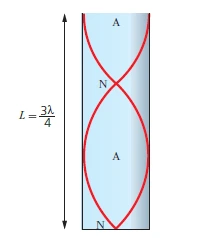
Second harmonic or first overtone
- Wavelength \( \lambda = \frac{4L}{3} \).
- \( f_2 = \frac{3c}{4L} \).
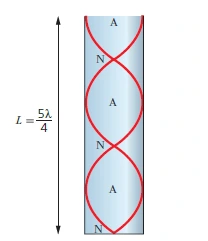
Third harmonic or second overtone
- Wavelength \( \lambda = \frac{4L}{5} \).
- \( f_3 = \frac{5c}{4L} \).
🔥 \( f_n = \frac{(2n – 1)c}{4L} \)
- This is the general expression for the frequency \( f_n \) of the \( n \)th mode of vibration of air in a closed tube (the \( n \)th harmonic, or the \( (n-1) \)th overtone).
Measuring the wavelength of stationary waves

- Source of microwaves facing a metal reflecting plate
- Stationary waves are produced by interference
- Probe detector is placed between the source and the reflector
- Position of the reflector is adjusted such that the signal fluctuates regularly as the detector is slowly moved back and forth
- \(\frac{\lambda}{2}\) = distance between successive minima (nodes) or maxima (antinodes).
Stationary waves using sound
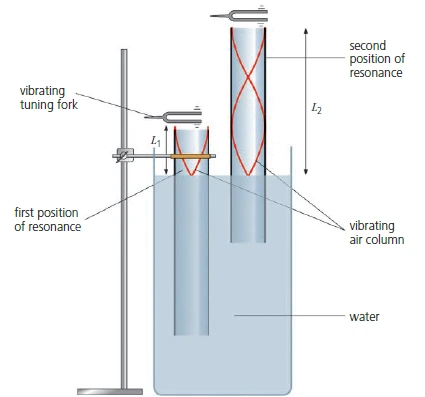
- A glass tube is placed in a cylinder of water
- A tuning fork or loudspeaker connected to a signal generator is held above the open end of the tube
- Tube is gradually raised (increasing \( L \)) until a stationary wave is produced (note becomes louder)
- First position: \( \frac{\lambda}{4} = L_1 + e \)
- Second position: \( \frac{3\lambda}{4} = L_2 + e \)
- \( \frac{\lambda}{2} = L_2 – L_1 \)
- \( c = 2f(L_2 – L_1) \)
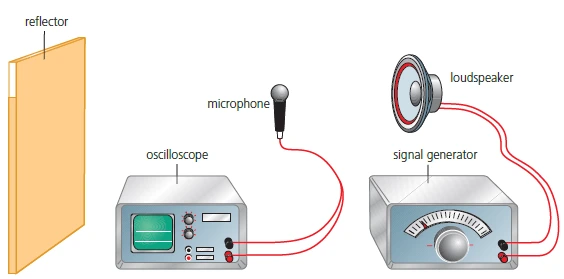
- Reflector is moved slowly back and forth until a stationary wave is produced
- Microphone is moved along the line between the loudspeaker and the reflector
- \(\frac{\lambda}{2}\) = distance between successive minima (nodes) or maxima (antinodes)
- \( c = 2f d \)
8.3 Diffraction and the diffraction grating
- Diffraction: The spreading of the wave into regions where it would not be seen if it moved only in a straight line after passing through a narrow split or past an edge
- Depends on the width of the gap compared with the wavelength
- Most noticeable when the width is equal to the wavelength
- There is no change of wavelength with diffraction
Huygens’ explanation of diffraction
- At any instance, all points in a wavefront could be regarded as secondary disturbances
- Give rise to their own circular wavelets
- The tangent curve of the wavefronts produced by the secondary sources gives the new position of the original wavefront
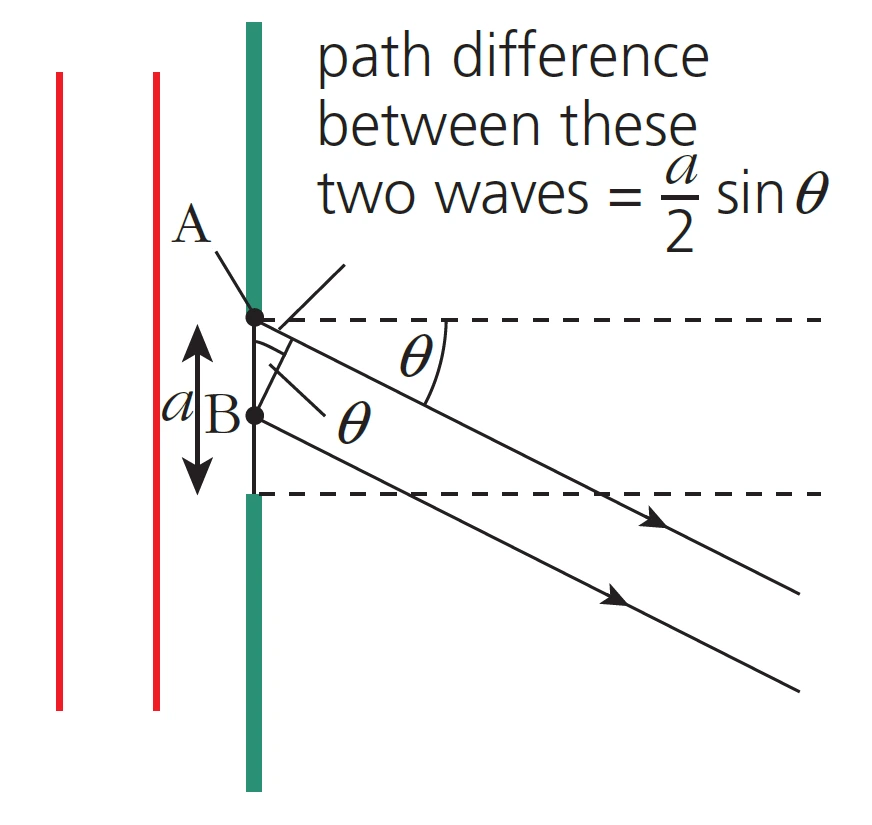
- Points A and B (separated by a distance of a/2) are sources of secondary wavelets
- Waves from A and B overlap to create an interference pattern
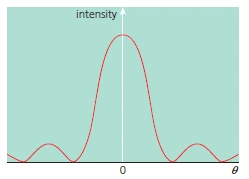
The Diffraction Grating
- A plate on which there is a very large number of parallel, identical, very closely spaced slits
- Condition for maximum intensity at angle \(\theta\):
$$ d \sin\theta = n\lambda $$
- \( d \) is the slit spacing and \( n \) is the order (0, 1, 2, 3, …)
- Used in a spectrometer
The Diffraction Grating with White Light
- Each wavelength making up the white light is diffracted by a different amount
- Red light is diffracted by the largest angle
- Blue light is diffracted by the least angle
- A continuous spectrum is produced at each order
- Depending on \( d \), overlapping of orders might occur
